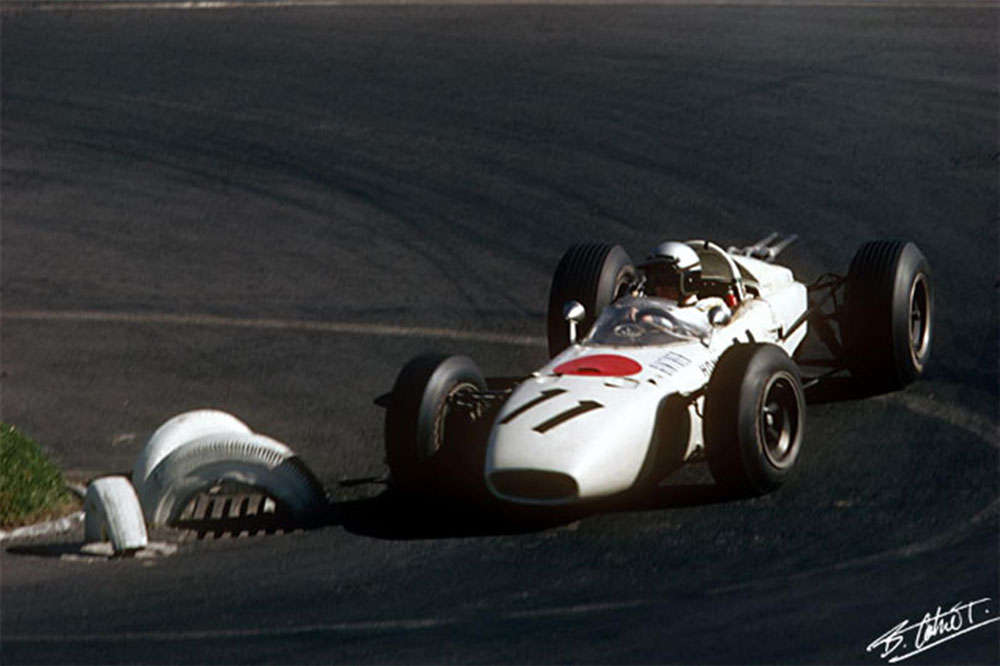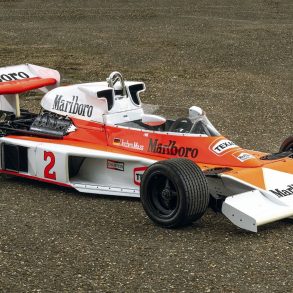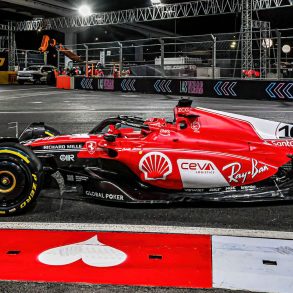Honda RA273
Car: Honda RA273 / Engine: 90º V12 / Maker: Honda / Bore X Stroke: – / Year: 1966 / Capacity: 2,993 cc / 182.6 cu in / Class: Formula 1 / Power: 400 bhp / 298 KW @ 10,000 rpm / Wheelbase: 2,390 mm Track: Front: 1460 mm Rear: 1440 mm / Weight: 743 kg

In 1937 he founded Tokai Seiki Heavy Industry, supplying Toyota and the Nakajima Aircraft company until an earthquake all but destroyed the factory in January 1945. After the war ended Soichiro Honda established the Honda Technical Research Institute. With a staff of 12 men working in a small shack, the company built and sold improvised motorized bicycles, using a supply of 500 two-stroke 50 cc Tohatsu war surplus radio generator engines. When the supply of engines ran out, Honda began building their own copy of the Tohatsu engine, and supplied these to customers to attach their bicycles. In 1949, the Honda Technical Research Institute was liquidated and in its place Honda Motor Co., Ltd. was incorporated. Honda hired engineers Kihachiro Kawashima, and Takeo Fujisawa who provided indispensable business and marketing expertise to complement Soichiro Honda’s technical focus. The close partnership between Soichiro Honda and Fujisawa lasted until they both stepped down in October 1973. The first complete motorcycle, with both the frame and engine made by Honda, was in 1949 and in a short time Honda became the world’s largest manufacturer of motorcycles. The first production automobile from Honda was the T360, a mini pick-up truck, which went on sale in August 1963. Powered by a small 356-cc straight-4 gasoline engine it was joined by the S360/500 convertible. Honda’s motorcycle origins were on display through it’s chain-driven rear wheels.
In May of 1962 Hideo Sugiura received a strange message from Yoshihito Kudo, director of the research center, that would change his life forever. Soichiro Honda, the company’s founder had decided that Honda would go automobile racing in something called Formula 1. In Japan’s hierarchical society, once a decision has been made by superior, especially one who’s name is on the building all energy would be dedicated to fulfill that decision. For Sugiura, that meant understanding what was this thing called Formula 1. Unbeknownst to him and the general public, the research department had somehow gotten their hands on a 2.5-litre Cooper – Climax, then still one of the leading competitors if not quite at the sharp end any longer. The team had originally planned to run a Honda engine in the then World Champion Lotus 25 chassis for 1964, but negotiations with Colin Chapman fizzled, leaving Honda with no choice but to build its own car and team from the ground up.
In January 1964 an announcement was made regarding Honda’s entry into F-1. The other Formula 1 teams were astounded by the audacity of the young Japanese company who would not only produce their own chassis but an engine to go along with it! Building upon a core group of engineers who had been involved in Honda’s motorcycle racing efforts Honda set about to hire the best and the brightest students from Japan’s universities which became a tradition at the technology driven company. Soichiro Honda would maintain a direct hand on this project first by deciding on a rough performance requirement for the engine, code named RA270, to produce 270 bhp from 1500 cc. This would be the responsibility of Akio Okudaira, who was in charge of engine performance. On February 6th, 1964 the first prototype was tested at their test facility near the Arakawa River. Soichiro Honda and Yoshio Nakamura drove the car for two laps around the course before handing off to their regular test team. Nakamura would later become Honda’s first F1 team manager.
Initially Honda would field a one-car team, with American Ronnie Bucknum, a 28 year-old California sports car racer who had never turned a wheel in a single-seater race car. Bucknum started racing in 1956 and was the winner of four Sports Car Club of America (SCCA) titles. It was said that some Honda engineers saw him racing a Porsche 904 at Sebring and in a tangled bit of Japanese logic it was thought that since the Japanese company did not have any motor racing experience it made sense to have a driver of corresponding status. A less charitable theory is that an inexperienced drive was less likely to ask uncomfortable question and that Bucknum was in a sense a sacrificial lamb. The Honda RA271 would make it’s debut at the daunting Nurburgring in Germany. During practice for the German Grand Prix on August 2, 1964, the Formula One community got its first look at the all-white car with the Rising Sun from Japan.
What greeted them was the gloriously raucous sound of its high-revving, 1.5-litre V12 Honda engine, mounted transversely in the chassis. The car qualified dead last but was able to hang on until a spin with four laps to go ended its race. After skipping the race in Austria, Bucknum qualified 10th in Italy and was able to make it as high as fifth before retiring with brake problems. Another DNF at Watkins Glen marked the end of Honda’s first year in Formula One. For 1965 Bucknum was joined by fellow Californian Richie Ginther driving an updated RA272 and the team would be based in Amsterdam. It was a new season and the Honda was starting to show some progress. The cars would always start quickly but over the length of the race would lose power relative to the rest of the field. At the final race in Mexico, at the the high-altitude (7,500 ft) Magdalena Mixhuca Circuit, Honda and Richie Ginther would win the Mexican Grand Prix while Bucknum scored a strong fifth and the calibrations were long and hard.
Afterwards his friend and Brabham driver Dan Gurney remarked that when he walked behind the Honda in the pits as it was warming up
… “its exhaust blast nearly tore the legs off my racing uniform. The sheer volume of gas that engine was passing was unbelievable. If that Formula (1,500 cc engine limit) had run another year I don’t believe we would have seen which way the Honda had gone. The rest of us would have been history …”
The car’s fuel injection had played a decisive role in maintaining power at high altitude. Honda has always had a reputation for producing strong engines and for the new 3-litre formula Shoichiro Irimajiri produced a 360 bhp V12. Unfortunately the car was once again let down by being relatively heavy and unwieldy.
Noted automotive historian Doug Nye, called it
“an engine man’s engine, with little practical thought devoted to the kind of chassis necessary to carry it.”
This is in contrast to current practice in Formula One where it’s all about packaging. Americans Ginther and Buckman returned as their drivers. At Monza Ginther qualified on the second row and was up to 2nd when a rear tire deflated causing Ginther to crash at the high-speed Curve Grande, luckily Ginther was none the worse for wear. Two new cars appeared at Watkins Glen but this only meant that two cars would fail to finish instead of just one. At Mexico Ginther led the first two laps before the engine steadily lost power and he had to settle for fourth place. The day was somewhat salvaged when he recorded the fastest lap of the race.
For 1967 ex-World Champion John Surtees would do the driving in addition to setting up Honda Racing in Slough, England. Things seemed to look up when he scored a third place at the season opener in South Africa but that would be the best result for the year. Honda was being distracted by their growing production car business and some of their best engineers on the Formula 1 project were transferred to the production side of the company. By the Italian Grand Prix a new car, the RA300 would appear on the grid.
The Honda engine was mated to a Lola based chassis leading the car to being nicknamed the “Hondola”‘ by the motoring press. The completed RA300 achieved an output rating of 420 bhp, while keeping the chassis weight to 610 kg. This should have been more than enough to be competitive and the team was ecstatic when Surtees took the lead on the final lap when Jimmy Clark’s Lotus was let down by a faulty fuel pump and Jack Brabham in a Brabham ran wide allowing Surtees to win by less than a car length.
For the 1968 season Soichiro Honda declared that Honda would compete using an air-cooled engine, having decided that a world class car had to be powered by an air-cooled engine. After some internal discussion Honda decided to build both water-cooled and air-cooled engines for the 1968 F-1 season.
The Honda RA301 would be powered by a water-cooled engine with a Lola chassis while the RA302 had an air-cooled engine and Honda chassis with several innovative features. The engine was cooled via two wide air intakes on each side of the cockpit which would catch air and funnel it through a venturi-effect system. The engine would be slung from an extension of the rear bulkhead. The driver’s position within the cockpit was moved forward with driver’s feet ahead of the front axles improving the car’s weight distribution. While the cockpit position was controversial Ferrari for one quickly adopted the design the next year followed shortly by the rest of the grid before it was banned due to safety considerations prior to the 1988 season.
While the RA301 was able to garner a second place at the French Grand Prix the RA302 was tested and dismissed by Surtees, who refused to drive what he called a “potential deathtrap”. It’s been said that Surtees suggested the team to build an aluminum version of the car to replace the flammable magnesium. The French department of the car manufacturer however urged the team to race the new RA302 to promote a new air cooled sedan and the car instead would be driven by Frenchman Jo Schlesser, but on lap two of the Grand Prix; Schlesser crashed at the Virage des Six Frères section of the circuit and the car came to rest sideways against a bank. The magnesium-bodied Honda and 58 laps worth of fuel ignited instantly, killing Schlesser and destroying the original RA302. While Schlesser did not have much experience driving Formula 1 cars it should be noted that he was a highly regarded competitor in European Formula Two and his fatal crash seems to have occurred due to the engine cutting out in a deceptively tricky downhill section of the course in the rain. Schlesser became the fourth driver to die that season following Jim Clark, Mike Spence and Lodovico Scarfiotti. A second RA302 was built, with slight modifications, earmarked for Surtees to drive at the next race, but when Surtees again refused to drive it, Honda decided to put a pause on their Grand Prix efforts.
Honda returned to Formula One in 1983 as an engine supplier for Spirit and later with Williams, Lotus, McLaren and Tyrrell. Between 1986-91 a Honda was the engine to have and powered teams to six consecutive constructor titles; two with Williams 1986-87 and four with McLaren 1988-91 along with five consecutive driver championships; one by Nelson Piquet in 1987, three by Ayrton Senna in 1988, 1990 and 1991, and one by Alain Prost in 1989. By the end of the 1992 season Honda-powered cars had won 71 Grands Prix.






















